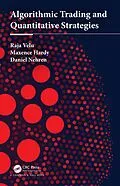Algorithmic Trading and Quantitative Strategies provides an in-depth overview of this growing field with a unique mix of quantitative rigor and practitioner's hands-on experience. The focus on empirical modeling and practical know-how makes this book a valuable resource for students and professionals.
The book starts with the often overlooked context of why and how we trade via a detailed introduction to market structure and quantitative microstructure models. The authors then present the necessary quantitative toolbox including more advanced machine learning models needed to successfully operate in the field. They next discuss the subject of quantitative trading, alpha generation, active portfolio management and more recent topics like news and sentiment analytics. The last main topic of execution algorithms is covered in detail with emphasis on the state of the field and critical topics including the elusive concept of market impact. The book concludes with a discussion on the technology infrastructure necessary to implement algorithmic strategies in large-scale production settings.
A git-hub repository includes data-sets and explanatory/exercise Jupyter notebooks. The exercises involve adding the correct code to solve the particular analysis/problem.
Autorentext
Raja Velu is a professor of Finance and Analytics in Whitman School of Management at Syracuse University. He served as a Technical Architect at Yahoo! in the Sponsored Search Division and was a visiting scientist at IBM-Almaden, Microsoft Research, Google and JPMC. He has also held visiting positions at Stanford's Statistics department, Indian School of Business, the National University of Singapore, and Singapore Management University.
Maxence Hardy is a Managing Director and the Head of eTrading Quantitative Research for Equities and Futures at J.P.Morgan, based in New York. Mr. Hardy is responsible for the development of agency algorithmic trading strategies for the Equities and Futures divisions globally.
Daniel Nehren is a Managing Director and the Head of Statistical Modelling and Development for Equities at Barclays. Based in New York, Mr. Nehren is responsible for the development of algorithmic trading and analytics products. Mr. Nehren has more than19 years of experience in equity trading working for some of the most prestigious financial firms including Citadel, J.P Morgan, and Goldman Sachs.
Klappentext
Algorithmic Trading and Quantitative Strategies provides an in-depth overview of this growing field with a unique mix of quantitative rigor and practitioner's hands-on experience. The focus on empirical modeling and practical know-how makes this book a valuable resource for students and professionals.
The book starts with the often overlooked context of why and how we trade via a detailed introduction to market structure and quantitative microstructure models. The authors then present the necessary quantitative toolbox including more advanced machine learning models needed to successfully operate in the field. They next discuss the subject of quantitative trading, alpha generation, active portfolio management and more recent topics like news and sentiment analytics. The last main topic of execution algorithms is covered in detail with emphasis on the state of the field and critical topics including the elusive concept of market impact. The book concludes with a discussion on the technology infrastructure necessary to implement algorithmic strategies in large-scale production settings.
A git-hub repository includes data-sets and explanatory/exercise Jupyter notebooks. The exercises involve adding the correct code to solve the particular analysis/problem.
Inhalt
I Introduction to Trading
1. Trading Fundamentals
A Brief History of Stock Trading
Market Structure and Trading Venues: A Review
Equity Markets Participants
Watering Holes of Equity Markets
The Mechanics of Trading
How Double Auction Markets Work
The Open Auction
Continuous Trading
The Closing Auction
Taxonomy of Data Used in Algorithmic Trading
Reference Data
Market Data
Market Data Derived Statistics
Fundamental Data and Other Datasets
Market Microstructure: Economic Fundamentals of Trading
Liquidity and Market Making
II Foundations: Basic Models and Empirics
2. Univariate Time Series Models
Trades and Quotes Data and their Aggregation: From Point Processes to Discrete Time Series
Trading Decisions as Short-Term Forecast Decisions
Stochastic Processes: Some Properties
Some Descriptive Tools and their Properties
Time Series Models for Aggregated Data: Modeling the Mean
Key Steps for Model Building
Testing for Nonstationary (Unit Root) in ARIMA Models: To Difference or Not To
Forecasting for ARIMA Processes
Stylized Models for Asset Returns
Time Series Models for Aggregated Data: Modeling the Variance
Stylized Models for Variance of Asset Returns
Exercises
3. Multivariate Time Series Models
Multivariate Regression
Dimension-Reduction Methods
Multiple Time Series Modeling
Co-integration, Co-movement and Commonality in Multiple Time Series
Applications in Finance
Multivariate GARCH Models
Illustrative Examples
Exercises
4. Advanced Topics
State-Space Modeling
Regime Switching and Change-Point Models
A Model for Volume-Volatility Relationship
Models for Point Processes
Stylized Models for High Frequency Financial Data
Models for Multiple Assets: High Frequency Context
Analysis of Time Aggregated Data
Realized Volatility and Econometric Models
Volatility and Price Bar Data
Analytics from Machine Learning Literature
Neural Networks
Reinforcement Learning
Multiple Indicators and Boosting Methods
Exercises
III Trading Algorithms
5. Statistical Trading Strategies and Back-Testing
Introduction to Trading Strategies: Origin and History
Evaluation of Strategies: Various Measures
Trading Rules for Time Aggregated Data
Filter Rules
Moving Average Variants and Oscillators
Patterns Discovery via Non-Parametric Smoothing Methods
A Decomposition Algorithm
Fair Value Models
Back-Testing and Data Snooping: In-Sample and Out-of-Sample Performance
Evaluation
Pairs Trading
Distance-Based Algorithms
Co-Integration
Some General Comments
Practical Considerations
Cross-Sectional Momentum Strategies
Extraneous Signals: Trading Volume, Volatility, etc
Filter Rules Based on Return and Volume
An Illustrative Example
…